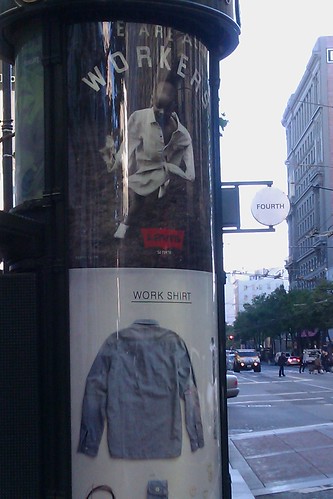
I spotted this Levi’s ad on Market Street downtown in SF, right in the heart of the shopping and financial district.
All this on the tail of a huge financial meltdown in our information/service/immaterial economy, rising unemployment, and sustainability crises that point their finger at us as a nation of consumers. And here, we have a consumer brand getting ahead of our anxieties by offering us the opportunity to consume worker-ness.
A press release gestures to “the history of laborers and artisans who shaped the cultural landscape of America.”
Levi’s is complementing their ad campaign by opening up workshops in SF and New York that double as community and retail spaces. The SF workshop will feature letterpresses, silk screen equipment, and photocopiers. New York will feature photography equipment.
At the very moment they pay homage to manual labor, they frame it as a temple to the embodiment in the information economy. The shops offer us ways to rediscover craft-y versions of our bits and pixels. Forgotten are the laborers — many Japanese and Chinese — who built American railroads at the turn of the century (or the racism they faced in forms such as the Chinese Exclusion Act of 1882). No hint of the giant factories where Costa Rican woman churn out masses of Levi’s jeans or the thousands of laborers in San Antonio, TX Levi’s left behind with 24-hours notice when they moved their shop overseas.
Even as Levi’s valorizes “workers,” it romanticizes an unaliented manual laborer of the past, evacuated of all the racism, sweat, and toil that characterized their actual work conditions. At once, it taps into an elite maker ethos to tap into anxieties of a country whose jobs always seem on the cusp of being done cheaper by someone abroad.
Jeep taps into the same sentiment with their ad telling Americans “This is a country of makers. And it is again.”
Tellingly, the railroad spike pounded in the ads first frame is pounded by a handless, raceless hammer. This is a nation of makers. But a lot of the makers were overseason labor — non-citizens — on “American” land.
This is just scratching the surface of analysis of these ads. I know other blog contributors, especially zinc and Lisa, know a lot about histories of racism, exploitation, and making. The connections between these ads, economic anxieties, labor class formations, DIY culture, and race/ethnicity could probably be a whole book.